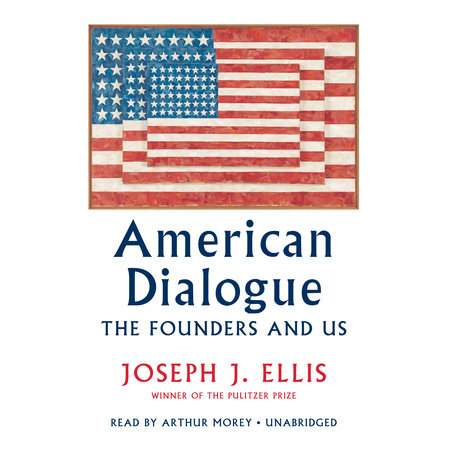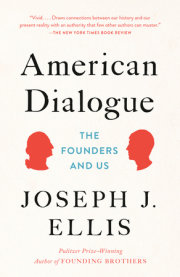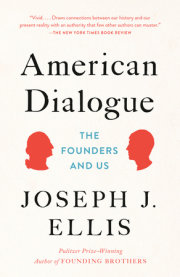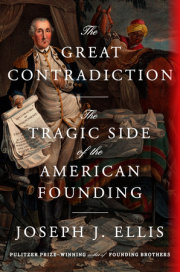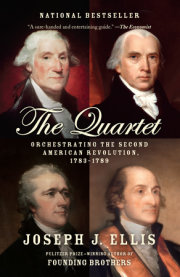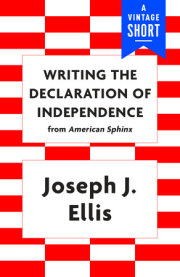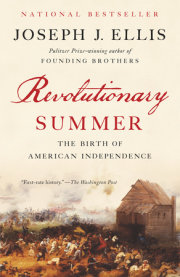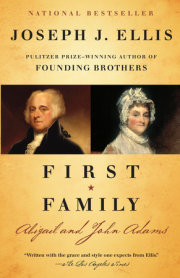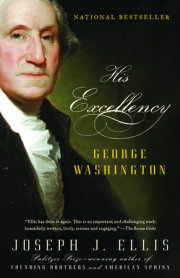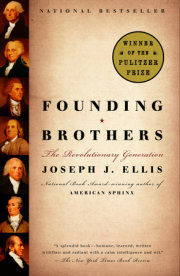PrefaceMy Self-Evident Truth
"History is always unfinished in the sense that the future always uses its past in new ways."
- Peter Gay,
Style in History (1974)
Self-evident truths are especially alluring because, by definition, no one needs to explain why they are true. The most famous example of this lovely paradox, which gave the term its name, is the second paragraph in the Declaration of Independence (i.e. “We hold these truths to be self-evident”), where Thomas Jefferson surreptitiously imbedded the creedal statement of the American promise.
The ironies abound, since Jefferson almost certainly did not know he was drafting the American Creed, and subsequent generations worshipped his words for reasons different than he intended. Moreover, his initial draft described the truths as “sacred and undeniable,” and it was probably Benjamin Franklin who suggested the change to “self-evident.” But, in the end, such nettlesome details have proven powerless against the sweeping influence of Jefferson’s message, which defined the terms of the liberal tradition in American history.
My professional life as a writer and teacher of American history has been informed by another self-evident truth. As I try to put it into words, I worry that the very act of self-conscious articulation might drain away the unconscious magic of my working assumption and expose it as an illusion. But let me try. It goes like this: the study of history is an ongoing conversation between past and present from which we all have much to learn.
There, having said it, I can see that the formulation is helpfully vague. It does not dictate what we can learn, and therefore casts a wide net that gathers in a messy variety of both personal and public lessons. Most of my experience comes from forty-plus years of teaching in a liberal arts college, where there is less distance between students and faculty. In such schools communication does not end with graduation, but lives on in a feed-back loop about the relevance and irrelevance of what had been learned years ago.
The dominant pattern was a random and wholly unpredictable kind of relevance. There was the Chinese student who had done a research paper for me on the Massachusetts Constitution, which was drafted singlehandedly by John Adams. This served as the inspiration, so she claimed, for her work back in Shanghai, writing a putative constitution for post-communist China. At her twenty-fifth reunion another student told me that her career as a corporate executive had been influenced by two lectures on the Civil War, one from the northern, the other from the southern perspective, which helped her to think ironically. Several former students, both women and men, reported that their efforts to negotiate the inescapable tension between career and family were informed by their reading of Abigail Adams’s letters, citing most especially her indomitable resilience.
Such examples suggest that I was not completely fooling myself in believing that history has something to teach us all, even though it was impossible to know at the moment of learning just what that something might be. Self-conscious attempts to teach or preach relevance in history are therefore unnecessary, because the connection between then and now is imbedded in the enterprise, fated to emerge in the future in unforeseeable ways. In that sense, reading history is like expanding your memory further back in time, and the more history you learn, the larger the memory bank you can draw on when life takes a turn for which you are otherwise unprepared.
***
Obviously, a few reassuring testimonials from former students do not a compelling case make. But since my belief in history’s utility was an unquestioned article of faith, it did not require overwhelming evidence, only sufficient support to sustain its credibility. And on that score the historical record provided several dramatic illustrations of a usable past that caught my eye. My two favorite examples featured John Adams during the American Revolution and Abraham Lincoln on the issue of slavery.
In June of 1776 Adams wrote to several friends in Boston, asking them to scour the Harvard library for books on military history, especially accounts of the Peloponnesian and Punic wars. He had just been appointed head of the Board of War and Ordnance, effectively making him secretary of war, a post for which he freely admitted he was wholly unprepared. He decided to give himself a crash course on how to manage an army.
Over the ensuing months he bombarded George Washington and the general officers of the Continental Army with advice gleaned from his reading. His most relevant strategic suggestion, which was based on his analysis of the battles between Thebes and Sparta as recorded by Thucydides, was to adopt a defensive strategy, what he called “a war of posts.” Much like the Spartans, Adams argued, the British were virtually invincible on a conventional battlefield, so the Continental Army should engage only when it enjoyed tactical superiority in numbers or terrain. Such advice cut against all of Washington’s aggressive instincts, but he eventually, if reluctantly, embraced it. The result was a protracted war that the British had to win, while the Americans had only not to lose. This proved a more attainable goal, eventually achieved when the British abandoned the conflict after the battle of Yorktown in 1781.
In 1858 Abraham Lincoln also began a research project, in his case focused on the records of the Constitutional Convention and the early histories of that seminal event. Lincoln’s research was prompted by the landmark Supreme Court decision,
Dred Scott v
Sanford (1857), in which Chief Justice Roger Taney, writing for the majority, ruled that the framers of the Constitution regarded slaves as property rather than persons, meaning that slave-owners could not be deprived of their property without their consent, which led to the conclusion that any law prohibiting slavery in the western territories was unconstitutional.
Lincoln’s reading of history led him to a dramatically different conclusion, namely that many of the founders sought to limit slavery’s expansion, a view which he presented in its fullest form in his Cooper Union Address (1860). He discovered that twenty-one of the thirty-nine signers of the Constitution were on record for banning or restricting slavery in the territories. Both Washington and Jefferson, as well as sixteen signers, endorsed the Northwest Ordinance, which prohibited slavery north of the Ohio River. Jefferson had even wanted to ban slavery in
all the new territories.
As for the larger question of slavery itself, Lincoln argued that the founding generation regarded it as a moral embarrassment that clearly defied the principles announced in the Declaration of Independence, which was the major reason the delegates in Philadelphia refused to permit the toxic term to contaminate the language of the Constitution. As Lincoln described them, the founders thought of slavery as a cancer they could not surgically remove without killing the infant American republic in the cradle. Throughout the trials and tribulations of America’s bloodiest war, Lincoln maintained he was acting as the agent of the founding generation, so that the Union cause spoke for the true meaning of the American Revolution.
It is worth noting that both Adams and Lincoln went back to the past with explicit political agendas, which is to say that they knew what they were looking for. So, for that matter, did Chief Justice Tanney, who harbored a proslavery agenda. By definition, all efforts to harvest the accumulated wisdom of the past must begin from a location in the present, so the questions posed of the past are inevitably shaped either consciously or unconsciously by the historical context in which they are asked. Unlike my former students, who discovered relevant historical insights later in life, almost accidentally, the Adams and Lincoln examples were self-conscious attempts to generate historical evidence in support of preferred outcomes. When it comes to the writing of relevant history, there are no immaculate conceptions.
This is an inconvenient truth that most historians acknowledge under their breath, admitting that objectivity, in the sense that mathematicians or physicists use the term, is not a realistic goal for historians. The best they can strive for is some measure of detachment, which serves the useful purpose of stigmatizing the most flagrant forms of ideological prejudice (i.e. cherry picking the evidence to claim that Thomas Jefferson was an evangelical Christian or Andrew Jackson a New Deal Democrat.) But if you believe that the study of history is an ongoing conversation between past and present, detachment itself is delusional. In his
Style in History (1974) Peter Gay put the point succinctly: “History is always unfinished in the sense that the future always uses the past in new ways.” In fact, the past is not history, but a much vaster region of the dead, gone, unknowable or forgotten. History is what we choose to remember, and we have no alternative but to do our choosing now.
***
My goal in the pages that follow is to provide a round-trip ticket to the late eighteenth century, then back to our location in the second decade of the twenty-first. The founding era has been chosen as a destination for two reasons: first, of all of the terrain in American history, I know it best; second, it produced the Big Bang that created all the planets and orbits in our political universe, thereby establishing the institutional framework for what is still an ongoing argument about our destiny as a people and a nation. Thus my title.
The questions we will be carrying back to the founding from our sliver of time in the present are inescapably shaped by our location in a divided America that is currently incapable of sustained argument and unsure of its destiny. We inhabit a backlash moment in American history of uncertain duration. Our creedal convictions as Americans, all of which have their origin in the founding era, are bumping up against four unforeseen and unprecedented obstacles: the emergence of a truly multiracial society; the inherent inequalities of a globalized economy; the sclerotic blockages of an aging political architecture; and the impossible obligations facing any world power once the moral certainties provided by the Cold War vanished. These obstacles became more difficult to negotiate in 2016, when the most inexperienced, uninformed, and divisive presidential candidate in American history occupied the Oval Office.
The
Now sections of the ensuing chapters represent my effort to place each of these topical areas—race, income inequality, jurisprudence, and foreign policy—in historical context by viewing them as recent entries in longstanding patterns. The
Then sections focus on specific founders, chosen in part because of their prominence, but mostly because, based on my previous work in their papers, each founder speaks with special resonance to the subject under scrutiny. Much in the way the founders went back to the Greek and Roman classics for guidance during the political crisis of their time, we are going back to the founders, our classics, in ours.
Our goal, then, is to learn more about our origins in the fond hope that doing so will allow us to frame the salient questions of our own time with greater wisdom than we are currently able to muster on our own. Moreover, the very act of posing such questions also enhances the prospects of viewing the founders themselves from new angles that cast their legacy in a different light. We can safely assume that the dialogue between now and then is an interactive process possessing the potential to change both sides of the chronological equation.
Although the founders are busy being dead, they still speak to use in the vast archive of letters and documents they left behind. The historical record is so rich because the revolutionary generation realized that they were “present at the creation” and therefore preserved their thoughts in the belief that posterity would want to remember them. Over the years, a small army of editors has worked assiduously on that preservation project, producing the fullest account of any political elite in recorded history. My attempt to recover the American Dialogue is wholly dependent on that documentary record.
Of course, the suggestion that there is an ongoing conversation across the centuries is a literary conceit, but we pay homage to the dialogue every time we cite the seminal texts of the founding to fortify our current convictions. As a lovely song once put it, the fundamental things apply, as time goes by.
In the pages that follow I will try to do justice to both sides of the dialogue. What did “all men are created equal” mean then and now? Did the “pursuit of happiness” imply the right to some semblance of economic equality? Does it now? Who were included in “We the people” then? Who is included now? Is it historically correct to describe the United States as an “exceptional” nation? If so, what are its current implications? Did the founders leave a legacy of government as “us” or “them”? If the correct answer is both, which legacy best meets our needs now?
Given our current condition as a deeply divided people, my hope is that the founding era can become a safe place to gather together, not so much to find answers to those questions as to argue about them. Indeed, if I read the founders right, their greatest legacy is the recognition that argument itself is the answer.
Copyright © 2018 by Joseph J. Ellis. All rights reserved. No part of this excerpt may be reproduced or reprinted without permission in writing from the publisher.

